Geneva Travel Guide
Thanks to its green parks, colourful gardens and lakeside promenades, Geneva is considered one of the healthiest places to live in the world. The city sits astride the River Rhone, where it streams into Lake Geneva, and is set against a dramatic backdrop of mountains. At the lake's south shore the Jet d'Eau shoots water 460ft (140m) into the sky from the end of a pier. It is the city's landmark attraction and Europe's most powerful fountain.
Undoubtedly Switzerland's most cosmopolitan city, Geneva's reputation for religious and political tolerance dates back more than five hundred years. In the 16th century the city spawned the religious teachings of John Calvin, and Geneva was where Lenin spent his 'years of recreation'. Little of their Puritanism is left today, when stately homes line the banks of the lake and overlook an armada of luxury yachts, and jewels and designer labels spill out of exclusive boutiques and into chauffeur-driven limousines that glide down palatial avenues.
As well as a host of museums and fine galleries, Geneva has a lively cultural calendar. Most notable is the celebration of l'Escalade in December, which involves costumed and torch-lit processions through the town, and the consumption of vast amounts of chocolate and marzipan.
Geneva is a gateway to Switzerland's luxury ski resorts, an important banking centre and home to thousands of international delegates and diplomats. Among the many international organisations based in the city are the United Nations and the International Red Cross.
Best time to visit Geneva
The best weather for a holiday in Geneva is experienced during the height of summer, July and August, but this is also the time when the city attracts thousands of tourists. Spring and autumn are less crowded and are pleasant times to travel to Geneva, though rain can be expected all year round. During late winter many travel to Geneva to access nearby ski resorts, and in December the city sees many tourists for the annual l'Escalade Festival.
What to see in Geneva
-Take in some culture at the Barbier-Mueller Museum.
-Marvel at one of the tallest fountains in the world, the Jet d'Eau.
-See true Swiss craftsmanship at the Patek Philippe Museum.
-Visit the cultural hub of Geneva, Place Neuve.
What to do in Geneva
-Bask in the stained-classed windows of St Peter's Cathedral.
-See the grand headquarters of the United Nations.
-Visit the cutting edge Museum of Modern and Contemporary Art.
-Explore the captivating Museum of Art and History.
Beyond Geneva
Geneva has an excellent transport network, including railways, roads and airlines. It is easy to get anywhere in and around Switzerland from Geneva; it is one of the best connected cities in Europe. From Geneva travellers have easy access to the Swiss Alps and other major attractions and ski resorts in the country, including the breathtaking Chateau de Chillon and the scenic town of Lausanne, which is situated on the sparkling shores of Lake Geneva.
Getting there
Flights to Geneva land at Geneva International Airport, located just two and a half miles (4km) from central Geneva.
Did you know?
-With 40 percent of its residents coming from outside of Switzerland, Geneva is the most international city in the world.
-Lake Geneva, located adjacently to the city, is the one of the largest lakes in Europe.
-Geneva is the birthplace of the internet as we know it today.
Things to do in Geneva
Sightseeing in Geneva offers something for everyone, as there are historic, cultural, religious and natural attractions galore, all within or very near to the city and best visited during the summer months. The most obvious attraction is Lake Geneva, one of the largest lakes in central Europe, and its Jet d'Eau, the huge fountain that shoots water 150 metres up into the air. Jardin Anglais is a garden that has been frequented by scribes and philosophers for years, and the nearby Ile Rousseau monument is dedicated to Jacques Rousseau and the inhabitants of Geneva.
Other things to see in Geneva include St Peter's Cathedral, a must for travellers interested in religious landmarks, and the Town Hall (Hotel de Ville), which is an impressive, 16th century neoclassical building. Maison Tavel (believed to be the oldest private house in Geneva) and the 18th century, Italian-style suburb of Carouge are historic Geneva attractions. With so much to offer, sightseeing in Geneva is indeed a rewarding experience.
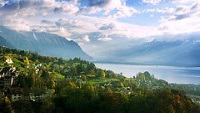
Lake Geneva (Lac Leman)
One of the largest lakes in central Europe and shared by both Switzerland and France, Lake Geneva (Lac Leman to its French-speaking inhabitants) has for decades drawn visitors to its shores. Attracted by the alpine panorama, quaint wooden chalet villages, vineyard-covered slopes and sailboats skimming across the blue waters, many famous writers, musical composers, actors and poets came to settle and the area has become something of an inspiration to the arts. Situated in the westernmost district of Vaud, the region contains a diversity of attractions and activities, from wine-growing villages and mountain ski resorts, picturesque castles, and magnificent cathedrals, to low-key lakeside resorts, boat cruises, and cosy fireside pots of fondue. Sophisticated shopping and cultural life can be found in the cities of Geneva and Lausanne, where there are sweeping views across the sparkling lake to the Alps and the distinctive pinnacle of Mont Blanc. Among the vineyards and affluent villas clinging to the slopes lie the lakeside towns of Vevey and Montreux, the pearls of the Swiss Riviera.
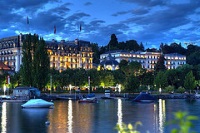
Lausanne
Located on the shores of Lake Geneva, the energetic city of Lausanne is built above the lake on a sequence of tiers connected by a small metro. The upper or Old Town contains the grand Gothic cathedral, Notre-Dame; its turreted towers a well-known symbol of the city. The lower town on the lakeshore was once the small fishing village of Ouchy and is now the prime waterfront area with outdoor dining and cafes, promenades and sporting activities. The gardens around the Quay d'Ouchy are home to the city's foremost attraction, the Olympic Museum, which contains a wealth of sporting memories and a collection of unique objects pertaining to the Olympic Games from its beginning until the present. Lausanne relishes its importance as the Olympic World Capital and headquarters of the International Olympic Committee.
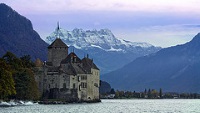
Chateau de Chillon
One of the best-maintained medieval castles in Europe, the 13th-century Chateau de Chillon is the most visited historical building in Switzerland. With its stunning lakeside location near the chic town of Montreux, jutting out into the water and framed by mountains, it is one of the most photographed castles in Europe. An important fortress in the Middle Ages, it was positioned to control the narrow passage between mountains and lake, protecting the major north-south route. It was also the favourite summer residence of the Counts of Savoy; while later, it served as a state prison. Visitors can tour the dungeons where the castle's most famous prisoner was chained for four years, the priest Francois Bonivard: a supporter of the Reformation. The fortress became famous when Lord Byron wrote about Bonivard's fate in an inspired poem entitled Prisoner of Chillon. Besides the dungeons, visitors can wander round the towers and courtyards, discover narrow secret passages, and see the grand knight's halls, frescoed chapel, luxurious bedchambers and rooms containing medieval weapons, furniture and paintings.
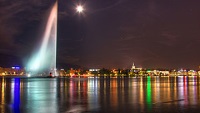
Jet d'Eau
One of the tallest fountains in the world, the Jet d'Eau is a Geneva attraction that cannot be missed. Projecting 460 feet (140m) into the air at a speed of 124 miles per hour (200km/h) and pumping 132 gallons (500 litres) of water per second, the fountain was initially established to release pressure for hydropower generation on the Rhone River, but was so loved by the populace that in 1891 the city created a permanent fountain. As Paris has the Eiffel Tower and New York has the Empire State Building, Geneva has the Jet d'Eau. For a breathtaking and romantic sight, tourists should visit at night, when the fountain is lit up.
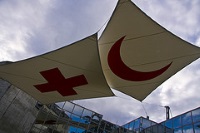
International Red Cross and Red Crescent Museum
One of the most creative and thought-provoking museums in Europe, the International Red Cross and Red Crescent Museum brings together sculpture, installation, photography and film to highlight the importance of human rights, the history of conflict in the 20th century and the humanitarian work the Red Cross has done in providing aid to combatants and civilians caught up in both war and natural disasters. Funded entirely by outside donors, the museum is appropriately situated on the hillside opposite the United Nations, within the headquarters of the International Committee of the Red Cross. A significant stopover on a visit to Geneva, the International Red Cross and Red Crescent Museum provides insight into the gross implications of war and the tragedy that surrounds, as well as the committed work of the volunteers and Red Cross representatives alike. All the exhibits have an English language option.
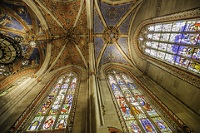
St Peter's Cathedral
With initial construction commencing in 1160 and lasting nearly a century, St Peter's Cathedral has over the years become a hotchpotch of Romanesque, Gothic and Neoclassical architectural styles. A former Catholic cathedral, St Peter's became a Protestant church in 1536 at the advent of the Reformation and was cleared of its ornate fittings such as altars, statues, paintings and furniture, though the stained-glass windows remained. Prominent theologian John Calvin preached at St Peter's Church between 1536 and his death in 1564, and the church soon became the centre of Protestantism. Recently, the remains of a fourth-century church were discovered under the existing building, providing an insightful look into early Christianity. Some of it is open to the public and can be viewed through the small museum on the site. For a breathtaking panoramic view of Geneva and Lac Leman, visitors can climb the 157 steps that lead to the summit of the cathedral's north tower.
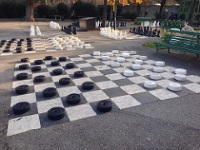
Public Parks
Public parks cover over one quarter of Geneva and provide a quiet haven of rolling lawns and tree-lined walkways. Dotted with many curious sculptures and attractions, they are certainly worth visiting. Bastion Park stands out, as it houses the 328-foot (100m) Reformation Wall, a monument commemorating the major figures and events of the Protestant Reformation, as well as life size-chess boards at the north end of the park. To view the famous flower clock, a symbol of the Swiss watch industry, visitors should head to the English Garden close to the water fountain and, for outstanding views of Mont Blanc and the lake, Park Moynier is a firm favourite. Park Moynier is also noted for being home to the History of Science Museum. Batie Woods is situated on the outskirts of the city and has twenty hectares of woodland and hiking trails.
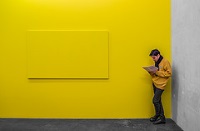
Museum of Modern and Contemporary Art
Opened in 1994, the cutting edge Museum of Modern and Contemporary Art refuses to conform and, as former museum director Christian Bernard says, the museum 'is not here to present the acceptable face of contemporary art'. With modern works dating from the 1960s to the present day, exhibited in a turn of the century factory, visitors to MAMCO will spend hours marvelling at the range of contemporary art that covers three floors. The Museum of Modern and Contemporary Art constantly reinvents itself, changing its exhibits and interior construction three times a year. The works of famous Dadaist Marcel Duchamp are on display all year round.
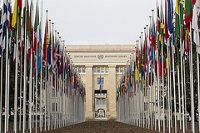
Palais des Nations (United Nations)
Built between 1929 and 1937 to host the League of Nations, the Palais des Nations now houses the United Nations Office at Geneva, which was inaugurated in 1966 after the dissolution of the League of Nations. The biggest United Nations station outside of the headquarters in New York, the office at Geneva provides critical support to the organization. Situated in 45-hectare Ariana Park, the extensive Palais des Nations is bordered by century old trees, and it is not uncommon to see peacocks darting around; the result of a request by the former owner of the land who bequeathed it to the City of Geneva on condition that peacocks may run freely on its grounds. Tours include the council room with frescoes by Jose Maria Sert and the Assembly Hall. Identity documents are required.
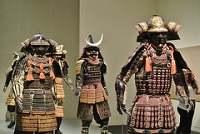
Barbier-Mueller Museum
Featuring a comprehensive collection of 7,000 artworks and artefacts from civilisations around the world, the Barbier-Mueller Museum in Geneva is the outcome of the tireless accumulations of Josef Mueller, whose collection began in 1907 and is continued to this day by his heirs. Founded in 1977, the museum wanted to preserve and study the sculptures, fabrics and ornaments brought from civilisations that were once isolated communities. Visitors should look out for the megalithic monuments from Indonesia, the statues and items of worship from Oceania, pre-Columbian art from the Americas and ancient masks and shields from Africa.

Place Neuve
The cultural hub of Geneva, Place Neuve sits just outside the former ramparts and is a great access point for the Old Town, which lies on the other side of the high retaining walls. Home to three of Geneva's regal performance and exhibition halls, the Grand Theatre (opera house), Conservatory of Music and Rath Museum, the Place Neuve is worth visiting to witness the architectural aesthetic of these buildings. In the centre of the square is the emblematic statue of Swiss general Henri Dufour, who was the first person to establish a map of Switzerland and also presided over the First Geneva Convention. The highest mountain in Switzerland, Dufourspitze, is named after him.
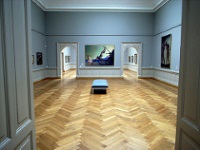
Museum of Art and History
Comprising three sections, the captivating Museum of Art and History explores the passage of western culture and international civilisations through over 7,000 pieces that cover archaeology (Roman, Greek, Egyptian and Etruscan), fine arts (paintings from the Renaissance to modern times) and applied arts (found objects from the Middle Ages to the 20th century). One of Geneva's largest museums, the colossal Museum of Art and History was built at the beginning of the 20th century, between 1903 and 1910. When visiting, travellers should look out for paintings by legendary artists Van Gogh and Renoir.
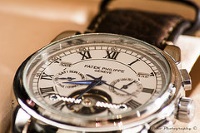
Patek Philippe Museum
The museum offers a fascinating presentation of Genevese, Swiss and European watches and enamels dating from the 16th to the early 19th century, including a great number of masterpieces that have left their mark on the history of horology. Audiovisual multilingual presentations of selected masterpieces animate the exhibit. Visitors can explore the roots of time-measurement through a visual timeline, which details the key events in watchmaking's evolution from the Antique creations of the 1500s, through to the founding of Patek Philippe in 1839, and up to the present day. The intricate details and designs, moving parts and beautiful colours of the collection will provide hours of fascination.
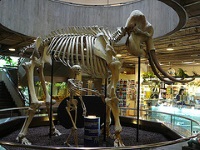
Musee d'Historie Naturelle
This museum presents an educational look at the world of nature, with special emphasis on the ecological history of Switzerland. Included is a life-size model menagerie of bears, foxes, alligators, aardvarks and other animals from around the globe, as well as a complete collection of every mineral and plant indigenous to Switzerland. There is also a special children's area. A great place to bring the kids, the Musee d'Historie Naturelle contains numerous historical collections left to the museum by world-renowned scientists, such as Lunel, Saussure and Fatio. Children will be amazed by displays of animals and specimens, including a leatherback turtle, giant spider crabs, tiger sharks and even a coelacanth.
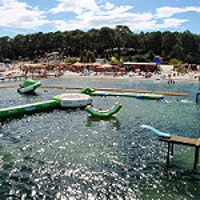
Aquaparc
A visit to Aquaparc is a must for families on holiday in Geneva, especially with children. This water park caters to children of all ages and features indoor and outdoor swimming and water adventure rides and slides in a tropical theme. Children will love rides such as the Devil's Fall and Morgan's Thrill, while parents can indulge in a massage with thousands of bubbles in the hot tubs. The water and the air are heated to 28C and some attractions are open all year round. Regardless of the weather (if it's raining, if it's windy or if it's snowing), Aquaparc is open.
Things to do with kids in Geneva
Geneva is a great city for children on holiday to explore. On warm days, parents can take the kids to the tropical Aquaparc, where they can splash and play, or enjoy a spot of horseback riding, putt-putt golf or bowling. Or for something special, they can pack a picnic and head to Labyrinthe Aventure in Evionnaz, where children can let off some steam in the 1.7 mile (3km) adventure maze.
On colder days when outdoor activities with kids are off the menu, families can head to one of the many indoor playgrounds found throughout the city, such as at Yatouland, which features bouncy castles, Noah's ark, slides and even a mini 4x4 circuit. There are many great things for children to see and do in Geneva, and the little ones need never be bored.

Public Parks
Public parks cover over one quarter of Geneva and provide a quiet haven of rolling lawns and tree-lined walkways. Dotted with many curious sculptures and attractions, they are certainly worth visiting. Bastion Park stands out, as it houses the 328-foot (100m) Reformation Wall, a monument commemorating the major figures and events of the Protestant Reformation, as well as life size-chess boards at the north end of the park. To view the famous flower clock, a symbol of the Swiss watch industry, visitors should head to the English Garden close to the water fountain and, for outstanding views of Mont Blanc and the lake, Park Moynier is a firm favourite. Park Moynier is also noted for being home to the History of Science Museum. Batie Woods is situated on the outskirts of the city and has twenty hectares of woodland and hiking trails.

Musee d'Historie Naturelle
This museum presents an educational look at the world of nature, with special emphasis on the ecological history of Switzerland. Included is a life-size model menagerie of bears, foxes, alligators, aardvarks and other animals from around the globe, as well as a complete collection of every mineral and plant indigenous to Switzerland. There is also a special children's area. A great place to bring the kids, the Musee d'Historie Naturelle contains numerous historical collections left to the museum by world-renowned scientists, such as Lunel, Saussure and Fatio. Children will be amazed by displays of animals and specimens, including a leatherback turtle, giant spider crabs, tiger sharks and even a coelacanth.

Aquaparc
A visit to Aquaparc is a must for families on holiday in Geneva, especially with children. This water park caters to children of all ages and features indoor and outdoor swimming and water adventure rides and slides in a tropical theme. Children will love rides such as the Devil's Fall and Morgan's Thrill, while parents can indulge in a massage with thousands of bubbles in the hot tubs. The water and the air are heated to 28C and some attractions are open all year round. Regardless of the weather (if it's raining, if it's windy or if it's snowing), Aquaparc is open.
Eating Out
Geneva offers a fantastic selection of traditional and local fare, as well as excellent international and ethnic cuisine. Local specialities include fresh fish from the lake and a variety of pork dishes, including petit sale (salt pork) and longeole (pork sausage). While Swiss cheese is enjoyed worldwide, Geneva has copious amounts of Raclette, Emmenthal and Gruyere, among other well-known cheeses on offer. These can be tasted in the quintessential Swiss fondue. Traditional Swiss restaurants can be found throughout the city but Place du Cirque and Quay Turrettini have some of the best.
Diners eating out in Geneva will find a variety of international restaurants offering modern, traditional, ethnic or fusion menus. There are good French restaurants in the hotels on Quai Du Mont Blanc and Chemin du Petit Saconnex and on Rue de Lausanne. For Italian eateries, travellers should try Rue de Fribourg, while Spanish food is best on Rue de Coutance. Rue du Prieure has a delightful Indian restaurant, and there are great cafes on Boulevard Helvetique.
While the prices at top restaurants can be astronomical, the standards are just as high. There are also fixed-price menus available to lighten the load. Many Geneva restaurants close on weekends and especially Sundays, so travellers should call ahead to enquire; reservations are recommended.
Shopping
Swiss jewellery, watches, wine and chocolate are the most popular tourist buys but, among all the shopping malls and boutique-lined streets, there are wonderful flea markets to discover, such as the Plainpalais Flea Market, which is held on the first Sunday of each month. The clothes and book market on the Place de la Madeleine is also great for bargain hunting.
The main area for shopping in Geneva is the Rues Basses, which is made up of Rue du Rhone, Rue de la Confederation and Rue du Marche, where all the best clothing and jewellery can be found. Travellers should visit to the Place du Mulard and enjoy browsing in some of the city's most glamorous and expensive shops or, for antique lovers, head to the old town, the best area to shop for antiques and art.
A shopping trip in Geneva wouldn't be complete without the obligatory purchase of the world-renowned chocolates that can be bought from one of the many confectioneries all across the city. However, for a real Swiss chocolate decadence, travellers should head to La Chocolaterie Rohr on Rue du Rhone and Place du Molard. Other popular Geneva souvenirs are the ubiquitous Swiss Army Knife, from established brands such as Wenger and Victorinox, and Swiss watches.
Most shops in Geneva open on Monday to Wednesday from 9am to 6:30pm while on Thursday shops close at 9pm. On Friday stores are open from 9am to 7:30pm. Shops open at 9am and close at 6pm on Saturdays and are closed on Sundays.
Nightlife
Geneva does not have the ribald party scene or vibrant nightlife culture that travellers might except for a city of its size and importance. Local youths tend to go to Lausanne when they let their hair down, and wealthy expats and local bankers frequent expensive restaurants and gentlemen's clubs.
The city's most lively areas are the Plaine de Plainpalais, which features many student bars due to its proximity to the University of Geneva, and the Place du Bourg de Four, near the old Town Hall, and it certainly has excellent classical music, opera and dance options. Other entertainment options include gambling at the Casino de Divonne and Movenpick Casino on the outskirts of town.
Getting Around
Geneva has a very dependable network of trams, buses, some trains and yellow taxi boats that cross the lake. The excellent bus and tram network operates from about 5am to midnight, with a night bus service running on weekends. Tickets must be pre-purchased and validated on boarding; however, tourists should receive a Geneva Transport Card from their hotel or hostel, which allows for unlimited free use of public transport. Taxi apps such as Uber and Lyft are also options. If there is no hurry, it is cheaper and more practical to walk or cycle. From mid-April to mid-October city bicycles can be borrowed from Geneve Roule outside the main train station free of charge for four hours. Taxis are plentiful but are generally an expensive means of transport. Driving in the city is not recommended, as parking is very difficult, but hiring a car is the most practical way to tour around Lake Geneva.
Geneva Climate and Weather
Geneva is situated at a high altitude, which together with the lake, tempers the prevailing continental climate. Summers are pleasantly warm to hot, and winters are relatively mild, with temperatures hovering just above or below freezing. In summer, between June and August, temperatures average between 54F (12C) and 79F (26C). In winter, between December and February, temperatures average between 29F (-1C) and 43F (6C). Rain falls all year round, and occasionally the city suffers the ravages of a harsh north wind known as the bise.
Switzerland travel info
Electricity
Electrical current in Switzerland is 230 volts, 50Hz. Plugs are of the linear, rounded three-pin type, but rounded two-pin plugs will fit the outlet.
Language
The four official languages are Swiss German, French, Italian and Romansch. Most people know at least three languages, including English.
Money
The official currency is the Swiss franc (CHF), which is divided into 100 rappen (German) or centimes (French). Although not part of the EU, many prices are indicated in euros and some merchants may accept euros. Credit cards are widely accepted and ATMs are widespread; many are equipped with the Cirrus or Maestro system. Banks offer the best exchange rates, but it is also possible to exchange money at major hotels, main train stations and airports. Banks are open Monday to Friday.
Tipping
A 15 percent service charge is normally included in all hotel, taxi, bar and restaurant bills, and further tipping is not necessary.
Health
Swiss medical facilities and health care are among the best in the world, but are very expensive, meaning health insurance is recommended. As of January 2021, most people cannot use a UK-issued European Health Insurance Card (EHIC) or a Global Health Insurance Card (GHIC) to get medical treatment in Switzerland. Everyone 16 years of age and older should get fully vaccinated for COVID-19 before travel.
Safety
Switzerland has a low crime rate compared to other European countries and is generally a safe country to travel in. However, there has been a recent increase in petty theft and visitors should be alert to pickpockets and thieves, particularly in the city centres and on public transport. Travellers should be aware of robberies on overnight trains.
Local customs
Privacy and discretion are highly valued in Swiss culture, and strangers generally do not speak to each other. The Swiss are naturally reserved and conservative, and prefer structured rules to govern their daily lives. Littering is a serious social crime in Switzerland, and visitors should also make an effort to throw their recyclables in the proper receptacle. French and German-speaking Switzerland have different customs in some areas. When being introduced to someone, German-speaking Swiss will shake hands, while French-speaking locals may kiss on the cheek three times (generally left, right, left). Though many Swiss speak English, it is considered polite to inquire before attempting conversation.
Doing business
The Swiss business world reflects the local mastery at building well-oiled machines. Efficiency and organisation are prioritised, and the business culture is based predominantly on merit. The country's formal, no-nonsense approach to business offers little room for humour or lack of preparation in meetings and, though the Swiss are slightly less pedantic than their German or French counterparts, they attach great value to appearance and punctuality.
Dress codes for business people in Switzerland are quite formal and conservative, particularly in the banking sector, where dark suits are the norm. Business and pleasure are entirely separate in the Swiss work environment. In keeping work and personal compartmentalised, Swiss businesspeople even shy away from calling their colleagues by first names, which reinforces formality and boundaries between work and play. When invited to a Swiss business associate's home, a small gift such as flowers or a box of chocolates is appropriate.
In Swiss business culture those in senior positions garner a great deal of respect, but decision-making processes are often quite democratic. Switzerland is home to over 1000 multinationals and has become something of a melting pot of business customs, regional influences and etiquette. English is the corporate language, particularly for multinationals. However, regional languages, such as French, German and Italian, are sometimes preferred in their respective areas. Swiss-German business meetings are rarely over food and are often as brief as possible, with little small talk. By contrast, Swiss-French and Swiss-Italians often meet over lunches and talk is not restricted to business. Handshakes are common for addressing both men and women. Business hours are from 8am to 5pm on weekdays with a lunch break from 12pm to 2pm.
Duty free
Travellers to Switzerland over 17 years do not have to pay duty on 200 cigarettes or 50 cigars or 250g tobacco; 2 litres alcohol up to 15 percent and 1 litre alcohol over 15 percent. The maximum allowance of wine is 20 litres, but duty will be payable on this quantity. VAT is liable if the total value of all goods exceeds CHF 300. Restricted items include meat and meat products from selected countries. Prohibited items are absinth and anaesthetics.
Communications
The international country dialling code for Switzerland is +41. Travellers can purchase local prepaid SIM cards for unlocked phones, and WiFi is widespread.
Passport & Visa
The borderless region known as the Schengen area includes the following countries: Austria, Belgium, Czech Republic, Denmark, Estonia, Finland, France, Germany, Greece, Hungary, Iceland, Italy, Latvia, Liechtenstein, Lithuania, Luxembourg, Malta, The Netherlands, Norway, Poland, Portugal, Slovakia, Slovenia, Spain, Sweden, and as of December 2008, Switzerland. All these countries issue a standard Schengen visa that has a multiple entry option that allows the holder to travel freely within the borders of all. It is highly recommended that travellers' passports have at least six months' validity remaining after the intended date of departure from their travel destination. Immigration officials often apply different rules to those stated by travel agents and official sources.
Entry requirements
US passport holders require a passport valid for three months beyond period of intended stay. A visa is not necessary for stays of up to 90 days within a 180 day period.
United Kingdom citizens require a passport valid for at least three months beyond period of intended stay, with the exception of passports marked 'British Citizen', 'British Subject' (containing a Certificate of Entitlement to the Right of Abode issued by the United Kingdom), and 'British Overseas Territories Citizen' issued by Gibraltar, which will be accepted if valid on arrival.
No visa is required for passports endorsed 'British Citizen', 'British Overseas Territories Citizen' issued by Gibraltar, Identity Cards issued by Gibraltar, and 'British Subject' (containing a Certificate of Entitlement to the Right of Abode issued by the United Kingdom). All other British nationals are entitled to a maximum stay of 90 days without a visa, within a 180 day period.
Canadian passport holders require a passport valid for three months beyond period of intended stay. A visa is not necessary for stays of up to 90 days within a 180 day period.
Australian passport holders require a passport valid for three months beyond period of intended stay. A visa is not necessary for stays of up to 90 days within a 180 day period.
South African passport holders require a passport valid for three months beyond period of intended stay, and a Schengen visa.
Irish nationals require a valid passport, valid for the period of the intended stay, but no visa is necessary.
New Zealand nationals require a passport valid for three months beyond period of intended stay. No visa is necessary for a stay of up to 90 days within a 180 day period.
Useful contacts
Swiss Tourist Office, Zurich: +41 44 215 4000 or www.myswitzerland.com
112 (General), 117 (Police), 144 (Ambulance).Embassies / consulates in other countries
Swiss Embassy, Washington DC, United States: +1 202 745 7900.
Swiss Embassy, London, United Kingdom: +44 20 7616 6000.
Swiss Embassy, Ottawa, Canada: +1 613 235 1837.
Swiss Embassy, Canberra, Australia: +61 2 6162 8400.
Swiss Embassy, Pretoria, South Africa: +27 12 452 0660.
Swiss Embassy, Dublin, Ireland: +353 1 218 6382.
Swiss Embassy, Wellington, New Zealand: +64 4 472 1593.
Embassies / consulates in Switzerland
United States Embassy, Bern: +4131 357 7011.
British Embassy, Bern: +41 31 359 7700.
Canadian Embassy, Bern: +41 31 357 3200.
Australian Consulate-General, Geneva: +41 22 799 9100.
South African Embassy, Bern: +41 31 350 1313.
Irish Embassy, Bern: +41 31 352 1442.
New Zealand Consulate-General, Geneva: +41 22 929 0350.



